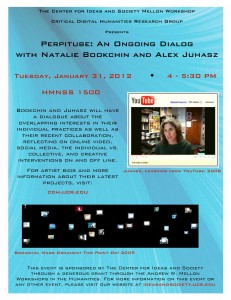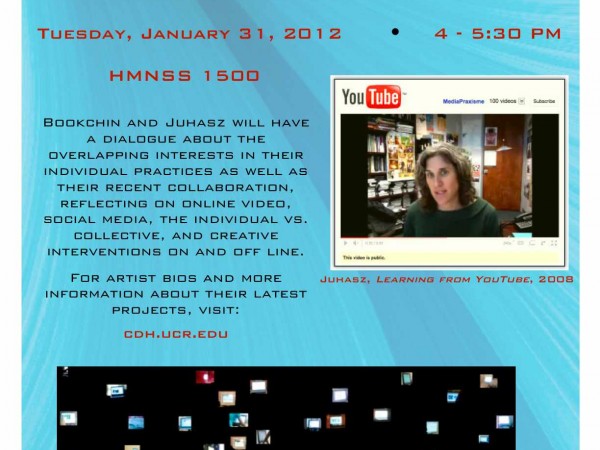(This is a re-post from the UC Humanities Forum)
“[I]t’s important to remember that IT has not altered the fundamental mission of the humanities: to preserve, monitor, investigate, and rethink our cultural inheritance, including the various material means by which it has been embodied and transmitted.”—Jerome McGann
Like many humanities scholars, I received, not too long ago, a copy of MLA’s Profession 2011, which has a fairly extensive section on “Evaluating Digital Scholarship,” and from which I’ve borrowed the above epigraph. Around that same time, I attended an excellent event hosted by UCR’s Critical Digital Humanities research group (and sponsored by The Center for Ideas and Society, with funding through the Andrew W. Mellon Workshops in the Humanities, many thanks). So, in keeping with the idea of “the future of the humanities,” I want to review the event, here, within the digital humanities framework for which McGann’s quote argues.
The event was entitled “Perpitube: A Dialog with Alex Juhasz and Natalie Bookchin.” Both speakers are scholars and artists who work with digital media and who have collaborated on projects exploring the affordances and limitations of some of these technologies. Both also engage in and produce “critical art,” and seek to investigate what it means to engage in scholarly and creative activity online.
(A brief aside: Though I don’t discuss the speakers’ numerous projects in any detail here, fortunately both of these inspired/ inspiring scholar/ artists make versions of their work available online. Visit Juhasz’s website for links to documentaries and feature films she’s produced, as well as articles, books, and blogs she’s written, including the impressively rhizomatic Learning from YouTube, the first video-book published by MIT Press. Bookchin’s website contains numerous links to her compelling videos, which largely remix, thematize, and orchestrate videos created and posted by a wide variety of web users.)
Juhasz describes one of the aims of her work as criticizing and making demands of the internet as we have received it, and attempting to do so on its own terms and through its own means. However, after her Learning from YouTube project, she’s admitted that “it is almost impossible to be critical of YouTube inside of YouTube.” Nonetheless, Juhasz suggests that these demands and critiques should be guided largely by an ethics imported from our practices of “lived spaces” (more on space in a moment)—for example, marginalized communities “offline” may find themselves confronted with dynamics of a similar nature “online.” Thus, imported ethics might include drives for visibility, voice, and community identity, all of which have historically and repeatedly been struggled over by individuals and communities in lived spaces.
Bookchin describes one core of her work as investigating new technologies and their social and political consequences. A central method consists of “locating tropes and commonalities we perform online and recasting their individual expressions as part of a shared social narrative.” In other words, if you’ve ever filmed yourself with a webcam dancing in front of your computer and posted it on YouTube, you might be a star! Through Bookchin’s skilled and nuanced orchestrations of numerous clips, however, you also might find your behavior start to look more scripted and constrained (by the technologies themselves, as well as social narratives) than you’d initially realized. If you have about seven minutes, check out Mass Ornament for a powerful example of the ways her work makes these connections.
Another commonality the artists shared was interest in investigating notions of space, which, as scholars familiar with digital humanities discourses will recognize, often gets collapsed into one of two perspectives: either, a) “people being together in a room is romantic and lost,” or b) “everything is answered now that we are online.” Juhasz and Bookchin, by contrast, are interested in putting these two polar perspectives in conversation to understand more clearly the possibilities and limits of each. Bookchin’s work, for example, is often in the form of immersive video installations in gallery spaces, portions of which get streamed online. Similarly, Juhasz’ Perpitube (co-curated with Pato Hebert), in which Bookchin was a participant, featured 29 days of video screenings at a gallery. Each screening is interactive with the audience, and is also captured on video, which is itself then screened the following day.
I guess that one of the things I find exciting about these complex works is that they engage in technological and artistic practices while functioning as scholarly, social, and technological critique. In other words, they’re situated within McGann’s “fundamental mission of the humanities” but perform these critiques, as Juhasz suggests, in the terms and through the means of the subject matter they study.


